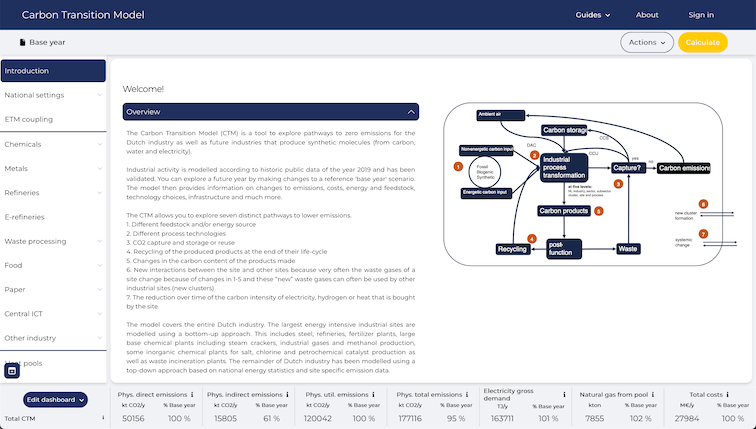Carbon Transition Model (CTM) (2020-now)


In 2020, several companies (Dow, Nouryon, Arcellor Mittal, Tata Steel, a.o.), an NGO (Urgenda), and two knowledge institutes (CIEP and Utrecht University) initiated a project under the coordination from the Institute of Sustainable Process Technology to build a tool that would allow simulations of different routes to make the fossil intensive industry CO2 neutral. Such a tool did not exist in 2020. The tool was named the Carbon Transition Model (CTM).
The CTM can simulate seven base routes for an industrial site to become (more) CO2 neutral between 2020 and 2050. The seven routes are: (1) change of energetic and/or non-energetic input to the industrial process, (2) change of the industrial process, (3) change in the amount of emissions captured, stored and/or reused, (4) change in the carbon volume in the end products that leave the site, (5) recycling of end products, (6) new cluster formation, and (7) emission reduction in electricity or heat bought from third parties.
The CTM in its first version contains full energy and material balances for a site and it models the assets on a site to a detailed level of approximately 10-15 assets.
Currently, the following Dutch industrial sites have been modelled on a process-level: six refineries, two fertilizer plants, three base chemical plants with steam crackers, three organic chemical companies, four inorganic chemical sites, two steel plants (one in Flanders), five waste processing sites. In addition, multiple clusters, sites, and sectors have been modelled using a generic, top-down method, such that the CTM covers all energy use and emissions of the Dutch industrt.
The CTM can be used in connection with the Energy Transition Model (ETM) developed by Quintel Intelligence. The ETM is a simulation model that covers the energy production and consumption in the Netherlands. The connection between the models allows for the calculation of scope 2 emissions for electricity and hydrogen on a national level on an hourly basis and the calculation of an approximation of what happens to the national electricity grid.
The ultimate goal of the CTM is to facilitate discussions between industry, government, grid operators and NGOs in order to reduce strategic binary uncertainty. With this, we mean that unless we know well in advance if an industrial site chooses for electrification, hydrogenation, CCS, or green molecule import, it will be nearly impossible to properly plan and invest in the right infrastructure for these companies. This is the case because depending on the configuration of an industrial site, a different infrastructure is needed and many choices are mutually exclusive. So, the decision of an enhanced high voltage infrastructure is diametrically opposed to the decision to go for CCS.
The CTM has been used to plan the transition by the grid operators in their II3050 work, the Dutch government and by the clusters and companies themselves. The industry can use the results to reiterate strategies, where the aggregated outcomes show goals not being met or other physical limits of resource availabilities being exceeded. The aggregated industry data and the CTM is also used for the benefit of the Outlook 2050 of the Ministry of Economic Affairs and Climate and the Interdepartemental Policy Research Group (IBO) for Climate Policies 2030 of various Ministries.
The model is open access and free of charge, which means that anyone can use it to explore how the Dutch carbon-intensive industry system reacts to different paths towards climate neutrality. The model can be accessed through the website carbontransitionmodel.com. A user guide for the model as well as technical documentation are available within the model, too.